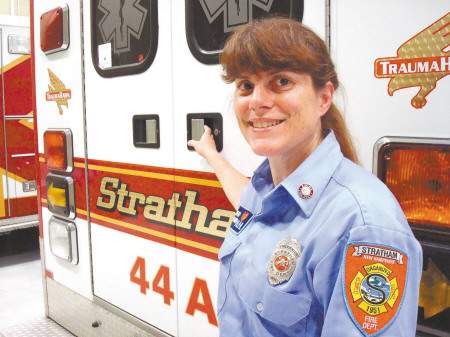By Dean Merchant
Hampton Union, Friday, June 27, 2008
[The following article is courtesy of the Hampton Union and Seacoast Online.]

[Dean Merchant photo]
A small, quiet cemetery protectively enclosed by a cut-granite stone wall is nestled next to the Union Meeting House on Route 150 in Kensington. Within its bounds are found the remaining rough fieldstone markers, once in rows, placed in remembrance of the many young children who died within the community during the “throat distemper” or “putrid throat” epidemic in 1735.
Here, parents grieved by their meeting house and prayed over the bodies of their little ones who had succumbed so quickly to the deadly corynebacterium diphtheria, today known as respiratory diphtheria.
In the first wave of burials were 150 children, their names or initials scratched into the rugged granite surfaces. The lichen-covered stones are now weathered and worn by centuries of New England storms and winters, but on some the lettering is still discernible. On a few the “IN” for infant is apparent; on one the barely legible date of 1735.

[Dean Merchant photo]
After 1735, many more emergencies of diphtheria plagued Kensington and the Seacoast, until the first effective vaccines came into widespread use two centuries later, finally bringing salvation to anxious parents hoping for a preventative for this childhood scourge, which was a leading cause of death in America for so long.
Kensington’s historical tomes are kept in a walk-in vault not far from the desk of librarian Janet Szarmach. Upon request Szarmach slips into the vault, emerging arms laden with the town’s church and cemetery records. The records reveal the magnitude of the deadly epidemic, its merciless rage running rampant upon the community’s youngest members for many generations.
Town documents record that 250 young child victims of diphtheria were buried in town between 1744 and 1779, their graves distinguished only by unmarked flat stones. Some of the small flat stones, sinking and lopsided, are still in place, collecting the sun’s warmth upon their surfaces, trailing vines of tiny ripening wild strawberries weaving amongst them.
The Rev. Roland Sawyer wrote of the 1735 epidemic in his history of Kensington. “Between June 1 and Dec. 1, 1735, there died over 40 children under 10 years of age. Seven families lost 27 children, everyone dying who was taken sick. The first 8 months of 1736 we lost near 40 more, or near 90 the first 15 months of the plague.” By 1738 so many Kensington children succumbed to diphtheria “there were few children left to die.” Sawyer notes statistics of other years when “throat distemper” ravaged the town — 1745 — 16 children died; 1747 — 48-52 children died; 1760 — 22 children died.
Hampton Falls (which then included Kensington and Seabrook) was the most devastated in the province by diphtheria. In his 1900 “History of Hampton Falls” Warren Brown writes, “Throat distemper raged most violently … Twenty families lost all of their children … Twenty-seven persons were lost out of five families, and more than one-sixth of the inhabitants of that place died in thirteen months … The number of deaths from throat distemper in this town for fourteen months preceding July 16, 1736 was 210, of these 160 were under ten years.”
Brown writes of the family that occupied his own house during the 1735 epidemic. “Lieut. Joseph Batchelder and wife … lost all their children, twelve or thirteen in number, it is not known which as Mrs. Batchelder afterward was unable to decide whether she had twelve or thirteen children.” The throat distemper first appeared in nearby Kingston (today’s East Kingston) in May 1735, and in 14 months it claimed 114 lives, 96 under age 10.
According to Brown, the first person seized was a child, who died in three days. Local reports at the time narrowed in on a sick hog eaten shortly before the outbreak. But, humans are the only known reservoir for diphtheria.
About a week after the first illness, another family, four miles distant, was attacked and three children died in three days. Of the first 40, all who were attacked died, Brown recorded. The epidemic reached Exeter in August of that year and Boston in September, thence marching down the East Coast.
The young minister of the Kingston parish, the Rev. Clark, lost his wife, baby and two other children to the “throat ail.” Worn, broken-hearted and exhausted, he gave up his parish, returned to his parents’ home in Exeter, and died early in 1737. Over the 14-month period, about 1,200 had died in 15 New Hampshire communities.
Barbara Rimkunas, curator of the Exeter Historical Society, is an expert on “throat distemper” in New Hampshire. Rimkunas, who has put together a program on the virulent 1735 epidemic, postulates that a lack of immunity in Kingston’s children, because of their isolation on farms, may have made them more vulnerable to the horrors of this outbreak of diphtheria.
In cities, Rimkunas explains, there was a “herd immunity” and less serious incidences of the disease.
She speculates the bacteria may have mutated into a more deadly form in Kingston before raging into other area farms and beyond.
In his book about epidemics William Beatty writes, “The throat distemper from 1735 to 1740 was clearly an ‘epidemiological complex.’ Severe diphtheria spread from Kingston, New Hampshire to Maine and Massachusetts.” Beatty also writes of a severe diphtheria epidemic in Cuzco, Peru, in 1614.
Through her research, Rimkunas has found accounts of diphtheria dating back to the time of Hippocrates in 500 BCE, but points out that outbreaks were not usually as deadly as that in 1735. She notes that Cotton Mather (noted Puritan minister) recorded throat distemper in 1659.
One noted New Hampshire doctor who earned a lasting legacy in his battle against diphtheria was Josiah Bartlett. During the 1754 Kingston outbreak, Bartlett treated patients with his controversial “Peruvian bark” with a measured success. Bartlett went on to become a signer of the Declaration of Independence and a New Hampshire governor.
Diphtheria, also known as the “strangling angel of children,” continued to wax and wane in New Hampshire over the next century. New Hampshire historian Peter Randall, a 12th-generation native whose family roots go back to the plague’s epicenter, tells in his “Hampton History” of the 19th-century outbreaks of the disease in Hampton. One was in 1866, leading to 14 deaths, seven in one family. The other was during the winter of 1890-91, when nine people died.
It was not until 1933 that an effective vaccine was used in Hampton, finally putting an end to the ineffective and torturous methods of treatment used over the centuries, such as bleeding from behind the tongue or from a vein in the arm. Soon, antibiotics would be added to the arsenal.
Perhaps one of the most famous diphtheria rescues was the 1925 “Serum Run to Nome,” also known as the “Great Race of Mercy.” Twenty mushers and 150 sled dogs relayed antitoxin 674 miles across Alaska in 5½ record-breaking days in record sub-zero temperatures to save the town from an incipient epidemic. (Native Americans are especially susceptible to diphtheria).
TODAY’S DEFENSE AGAINST DIPHTHERIA

[Dean Merchant photo]
Kathy Flagg, her daughter in tow, grabs a quick cup of morning coffee at the Blue Canoe. At first blush, she would be taken for any other Stratham soccer mom ready to begin the myriad of daily tasks.
But this is also Lt. Flagg, firefighter, EMT, and deputy director of Stratham’s Office of Emergency Management. Flagg has had a lot of training to qualify as a first responder to area emergencies. She is one of the decision makers should her community face a pandemic, such as an outbreak of a new strain of avian flu. She is also prepared to handle tornadoes, tank turnovers, hazardous events or a nuclear emergency.
The OEM is located at the town’s new safety complex. Flagg explains that Stratham, with 19 other towns, is part of Region 13, a program that was created to prepare for emergency large-scale inoculation of the population. “We plan for the how and where to do it in a short period. We create programs that would have a smooth flow, not scurrying around having to engage in pre-planning and loss of time,” she says. Looking at the fireman’s pin on her uniform, she says her father was also a volunteer firefighter. “He was at my graduation and pinned me, making it extra special,” she says.
MODERN DAY DIPHTHERIA
Diphtheria is an infectious and communicable disease reportable to the CDC (Centers for Disease Control). The CDC recorded only 57 cases in the United States between 1980 and 2994, compared to the World Health Organization’s report of 3,978 cases worldwide in 2006 alone.
The last major outbreak in the United States was in Seattle in 1971.
Nevertheless, diphtheria continues to be an active disease worldwide, primarily in undeveloped countries.
After the breakup of the Soviet Union in the early 1990s, their medical system in disarray, there was a major diphtheria outbreak; 150,000 persons were afflicted; 5,000 died. Another outbreak, in Afghanistan in 2003, was quickly quelled when vaccines and antibiotics were rushed to the scene.
In 2003, an unvaccinated Pennsylvania man returned from Haiti after a volunteer work program.
Taken ill, it took nine days to diagnose diphtheria, and he subsequently died. (Older Americans who have not had a booster are currently most at risk to the disease in the United States.)
In 2005 a Haitian-born Massachusetts woman had a suspected case of the disease. Her husband tested positive as an asymptomatic carrier of diphtheria.
MEDICAL COMMUNITY ON GUARD
Dr. Everett Lamm is a warm and engaging pediatrician who resides in Stratham. Lamm has not heard of a recent case of diphtheria in the Seacoast area. But he stresses the importance of children receiving the DTaP vaccine (for diphtheria, tetanus and pertussis).
Lamm cites an increasing number of incidences of pertussis or whooping cough. Like diphtheria, whooping cough is a respiratory illness and Lamm is concerned about a growing trend in parents opting out of vaccinations for their children as a result of the ongoing vaccination discussion. “This has led to a backlash not clear to the medical community,” says Lamm. “As a result we are seeing an increase in whooping cough. It is a serious illness and can lead to seizures, respiratory failure and death.”
Lamm also recommends that all children over age 11 receive a booster of the newer vaccine. “We never want to see a return of these diseases due to a misunderstanding about vaccinations.”